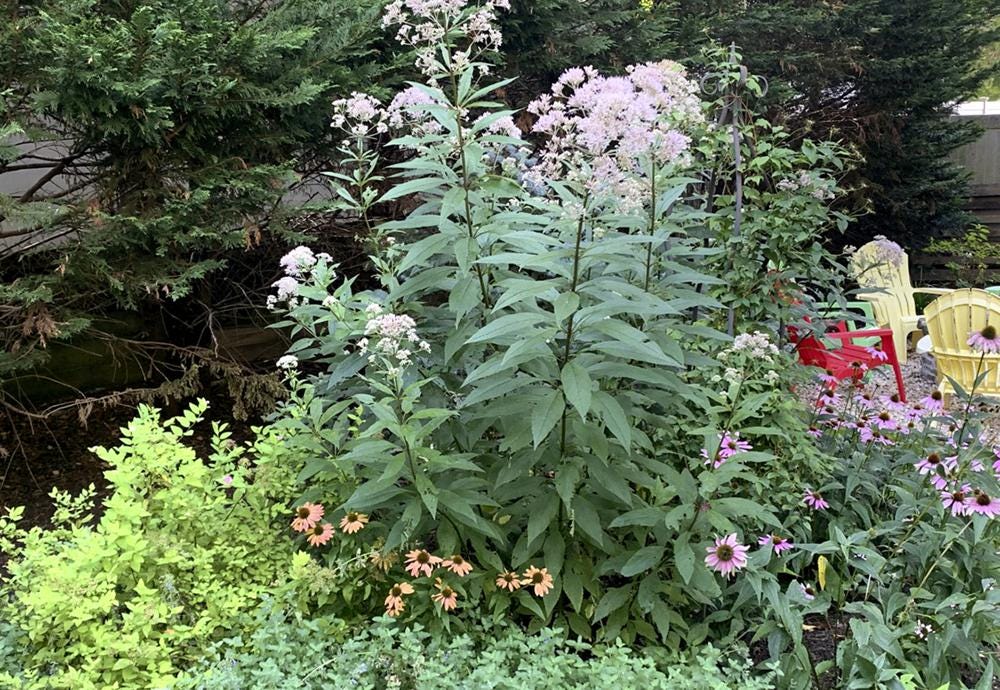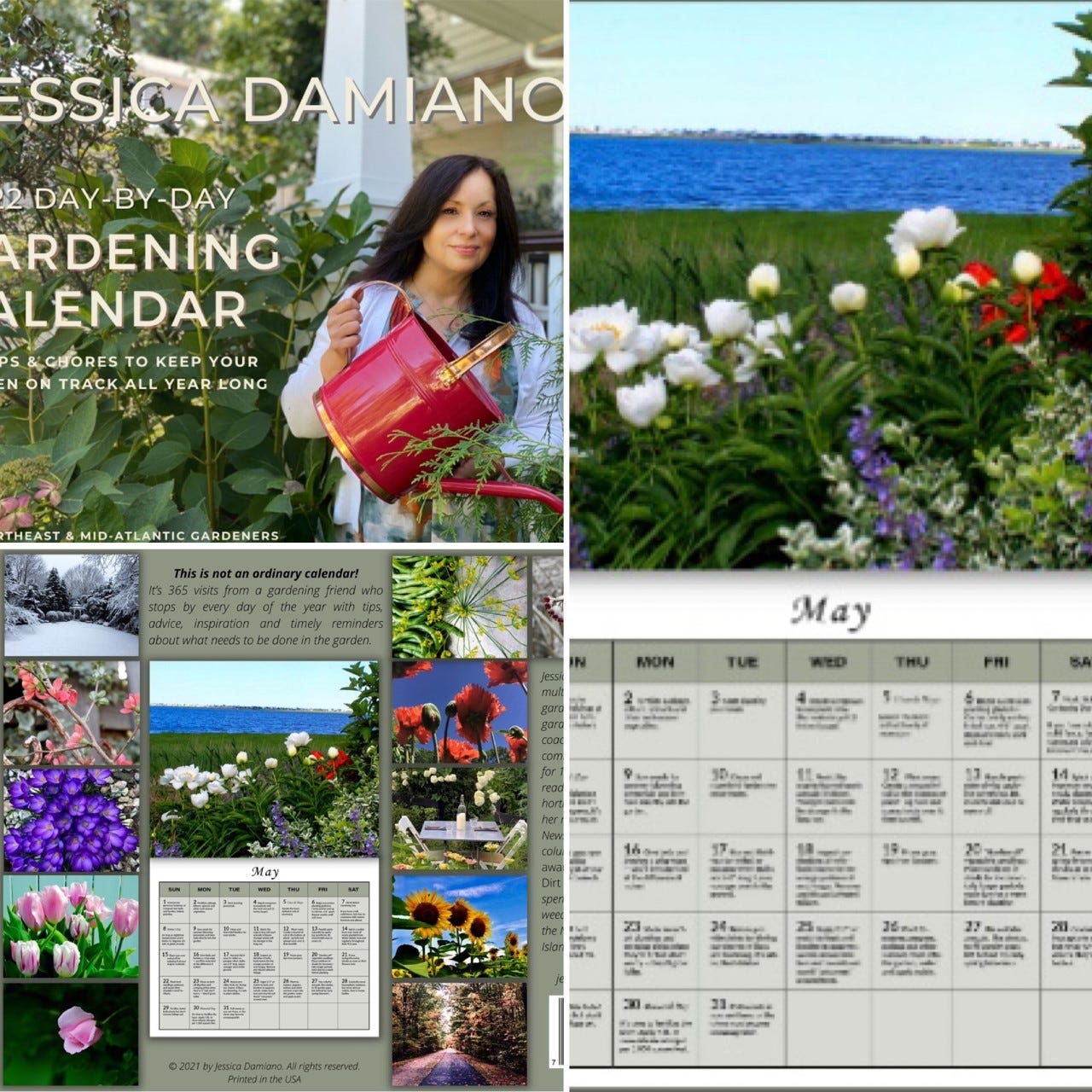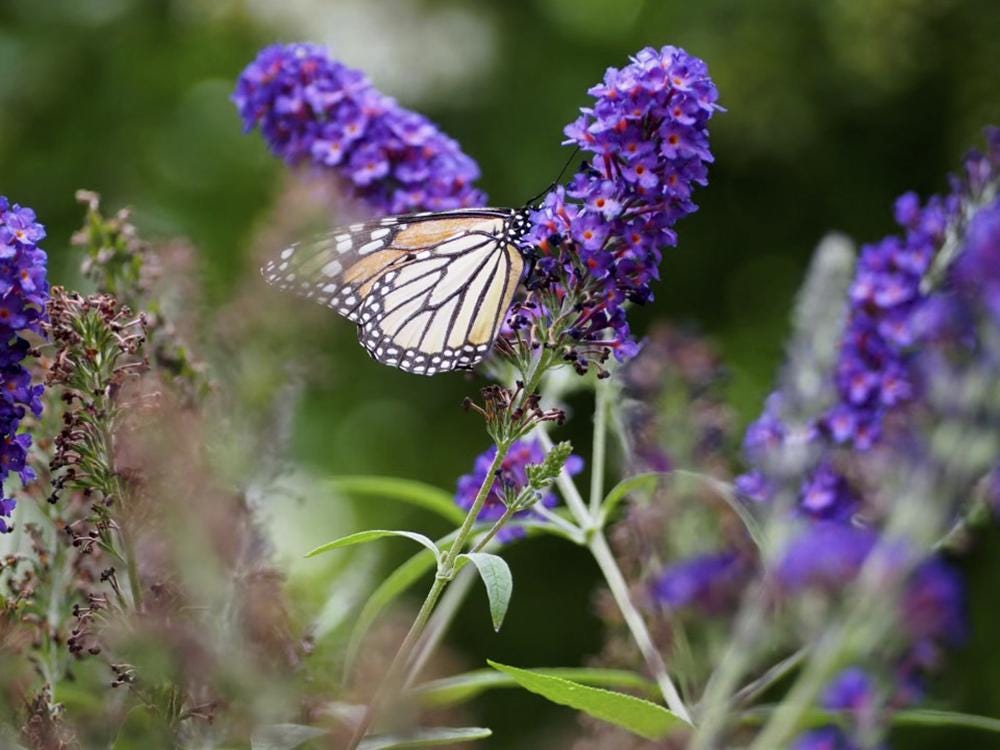If you’re a first-time visitor, welcome! To receive The Weekly Dirt in your inbox every week…

Hi, guys!
I’ve been writing quite a bit about the importance of native plants for awhile now, and it isn’t lost on me that many home gardeners who understand the role they play in our ecosystem and would like to grow them feel overwhelmed by the prospect of starting from scratch.
I’m here to tell you that you don’t have to.
Sure, ideally everyone would rip out their Japanese barberries, butterfly bushes and burning bush euonymuses — and all their other nonnative plants, even if they’re not invasive. Most don’t feed our birds and pollinators, and some do but the food they provide is the equivalent of junk food. Other introduced species seem to be magnets for bees and butterflies, but upon closer inspection it becomes clear they’re *trying* to get nectar and pollen out of the flowers but can’t because of double blooms or other “desirable” traits that have been bred into them.
So what’s a gardener to do? Start small.
Planting just one native plant that will feed one pollinator in one container is a good start. If everyone did that, we’d be well on our way.
I don’t pretend to be perfect. The importance of growing natives started to come to my attention — in dribs and drabs — about 13 years ago. And within the last 7 years, it really clicked. Before that, I’d planted things like Japanese barberries, butterfly bushes and burning bush euonymuses, among others. And I still have some of them because, again, baby steps, even for me.
But after several years of bringing home only native plants (except annuals) and replacing declining nonnatives with native alternatives, I’m just passing the 50/50 point in my native/nonnative ratio. And I’ll continue to grow from there. I hope you’ll join me.
I wrote more about this topic in my AP column last week, which you can read here.
💡 If you do one thing this week…
If you’re growing herbs (or over-bought at the farmers’ market), the best way to preserve them is to freeze them. It’s so easy to make your own infusions for use year-round.
Harvest herbs in the morning, after the sun has risen but before the dew has dried, for the best flavor (figure around 9 a.m.)
1. Rinse and pat dry.
2. Cut — ideally using herb snippers — into quarter inch pieces.
3. Place clippings into a silicone herb freezer tray like this one.
4. Fill tray compartments with oil of your choice (I use olive oil).
5. Freeze overnight.
6. Remove cubes from tray and store in zipper-top freezer bag.
Add a cube or two to soups, stews, sauces and other recipes all year long—until the next harvest!
🔥50 % OFF FIRE SALE!
Grab one of the remaining copies of my 2022 Day-by-Day Gardening Calendar at half price — just $12.50—while they last! That’s less than 25 cents a week for 365 garden tips and chores.
If you’re unfamiliar, hanging one of these babies on your wall is like having a complete gardening course in a wall calendar! I’ve included 365 tips and chores to ensure your garden stays on track every day of the year. You’ll never miss a sowing, planting, fertilizing, pest-control or other important gardening date again!
By the end of the year, I promise, you’ll have earned a green thumb! Plus, your wall will be adorned with award-winning photography provided by The Weekly Dirt readers.
Grab one today while it’s on your mind because when they’re gone, they’re gone (and I’m not going to publish a wall calendar for 2023). Take a look:
📬 Ask Jessica
DEAR JESSICA: These trees belong to my neighbors and are planted at the border of my property. They are many years old, but this year, for the first time, they have produced seedlings that have spread to my entire lawn, under every bush and tree, in the front, the back — just an invasion the likes of which you can’t conceive.
Jessica, what type of tree is this? In years gone back, it was trimmed annually. The new neighbors do not believe in trimming, unfortunately. I have spoken to her and asked that it be trimmed this year.
The seedlings grow quickly and must be hand pulled before they take solid root. It is a nightmare for me. I cannot mulch until they have been totally removed. I have been weeding for days now. Any information would be appreciated. —Nancy Stepkowski, Locust Valley
DEAR NANCY: Those are Amur maple trees, nonnatives that have invasive qualities, especially in the north and northeast, where they are naturalizing in fields, forests and roadsides. Yes, it’s a problem.
And some years it’s more or a problem than others: Seed- and nut-bearing trees like maples have so-called “mast years,” which are exceptionally successful growing seasons that result in mass-seed production the following year. This happens roughly every 2-5 years.
Poor pollination also can result in an abundance of samaras, which are those seed-containing “helicopters” or “polly noses” that children like to play with.
I’m not convinced pruning has anything to do with it unless your previous neighbors timed prunings during spring, after the trees leafed out but before they dropped samaras. Even if that’s the case, unless they pruned severely every year, it isn’t likely to have made a difference.
The best defense is to rake up the seedpods when they fall in spring before they have a chance to root.
👏 Sunday shoutout

James Jones, MD, PhD, of Jacksonville, Fla., says he’s “been doing hydroponics for years and recently moved my plants outdoors” into two beds he made from 40-gallon tanks. He partially buried a 30-gallon tank that he keeps filled with nutrients, and runs a small pump for one minute each day to direct the fertilizer to each larger tank. “I can run this for a week unattended,” he said.
“I've got 27 indeterminate heirloom tomatoes in 12-square-feet of space in the two tanks, which are on a rail off the ground, hopefully making pests less of an issue.
The white cage holds strings that support and guide the plants.”
📰This week in my Associated Press gardening column
I write a weekly gardening column for the AP, so you might have seen my byline in your local paper (or news website) — wherever in the world you happen to be. In case you miss it, I’ll post the most recent here every week.
Embracing native plants doesn’t have to be all or nothing: Baby steps will go a long way toward helping pollinators and the environment. Learn how easy it is to get started (does one plant sound like too much?)
Pollinator-friendly pest control: Yes, you can protect your plants without killing pollinators. Just take care to follow these guidelines.
Preparing a garden for severe storms—and cleaning up after.
Do we have to separate you two? Best, worst companion plants for a healthier, pest-free garden
Common gardening mistakes — and how to avoid them: Much of gardening is learned by trial and error -- and, unfortunately, that’s mostly error. Learn how to get ahead of those blunders for a healthy, productive garden.
Not all shade is the same: Gardening where there's little sun: Gardening in the shade doesn't have to mean limited plant choices and lack of color. The first step is understanding which type of shade you have. Click in for guidance and plant suggestions.
Sunflowers! Homegrown sunflowers are popular, native and, for some, newly meaningful. Learn how to grow them— and how to harvest and roast their seeds.
Plant this, not that: Native alternatives for 8 popular invasive plants.
Go Native! If your idea of the perfect garden includes abundant plants that do well with little human intervention, while attracting and supporting all manner of pollinators, plant natives. Here’s what you need to know to get started.
Annuals to plant for old-time nostalgia: Longing for grandma’s flowers? Here are 8 vintage garden favorites.
Filling raised beds? Save money—and grow better—with Hugelkultur: Hugelkultur is a different, more natural (and cheaper) approach to raised beds or mounds that doesn’t require so many bags of top soil or compost. Instead, you fill the space with organic matter that gradually decomposes, feeding the soil and plants. Here’s how.
Growing veggies in small spaces: Smaller new varieties can yield great results for vegetables grown in containers.
Want more? You can read all my AP gardening columns here.
Let’s be friends! Follow me @JesDamiano on Instagram
📧 How’m I doing?
I welcome your comments and suggestions, so please send them along — as well as any topics you’d like to see covered and questions you’d like answered in the Ask Jessica section.
And if you’re enjoying this newsletter, please share it with a friend!










How to make and freeze herb infusions